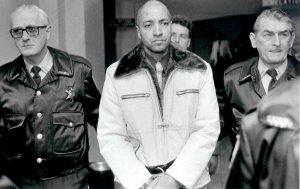HARRISBURG, Pa. (AP) — George Banks, one of the most notorious mass murderers in the U.S., has died.
Banks, 83, died Sunday afternoon at Phoenix state prison in Pennsylvania, the state Department of Corrections said. Banks died of complications from renal neoplasm, or kidney cancer, said Montgomery County Coroner Dr. Janine Darby.
Banks had been in prison since 1982 after shooting 14 people, and killing 13, including his own children, during a rampage in Wilkes-Barre. At time, it was considered one of the worst mass murders in American history. He was convicted of 12 counts of first-degree murder and one count of third-degree murder.
Banks had been drinking at a party late at night before using an AR-15 rifle to start the rampage at his home.
Five victims were his children, ages 1 to 6. Four more were the mothers of his children. Other victims were bystanders, including an 11-year-old child who sometimes stayed with his family, a 7-year-old child and a teenager who saw Banks leaving his home armed with the rifle and recognized him.
Banks killed three women and five children at his home, authorities say. Then, dressed in green army fatigues with an ammunition bandolier around his chest and shoulders, Banks left, when he saw four teenagers walking to their car from a nearby friend’s house. He shot one fatally, and another, who survived, authorities say.
He stole a car and went to the Heather Highlands Trailer Park where police found the bodies of Banks’ son and the child’s mother, as well as her mother and her nephew.
From there, Banks went to his mother’s house, who told police that Banks told her, “I killed them. I killed them all,” court records say.
Banks eventually surrendered after a four-hour standoff at a friend’s house after police tried to convince him that his victims had survived.
Eventually, state courts prevented his execution, saying he wasn’t mentally competent. That left Banks with a sentence of life imprisonment.
The teenager who survived being shot by Banks, Jim Olson, later expressed frustration in 2012 that Banks hadn’t been executed, saying, “What is the sense of having a death penalty if you don’t use it or enforce it?″
Defense lawyers had argued that Banks was insane when he went on the shooting spree.
After his arrest, Banks, who was biracial, claimed he had killed his children to save them from the pain of growing up in a racist society. During his trial, he overruled his lawyer on strategic decisions, and argued instead that prosecutors, the judge and the mayor of Wilkes-Barre were conspiring against him.
Banks also showed the jury gory pictures of his victims, even after his lawyer had successfully gotten the photos barred on the grounds that they were gruesome and prejudicial.

